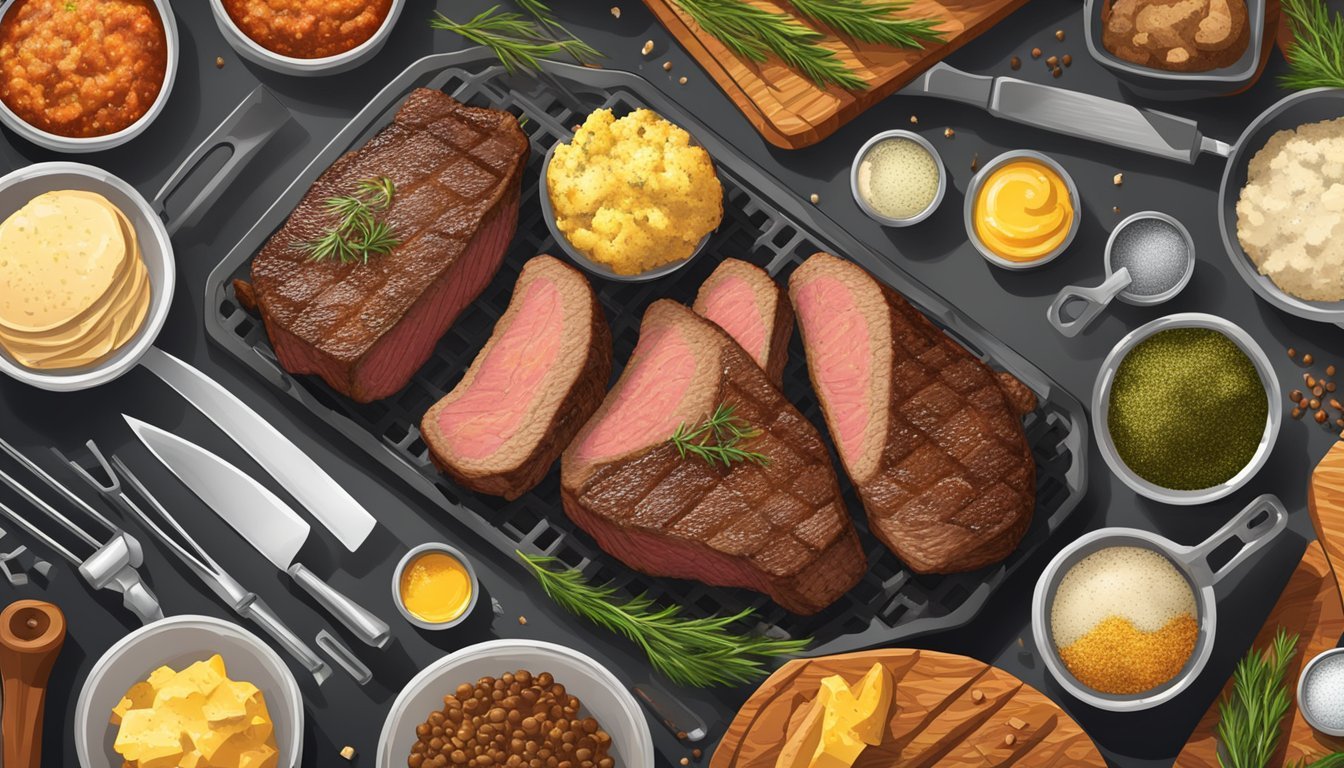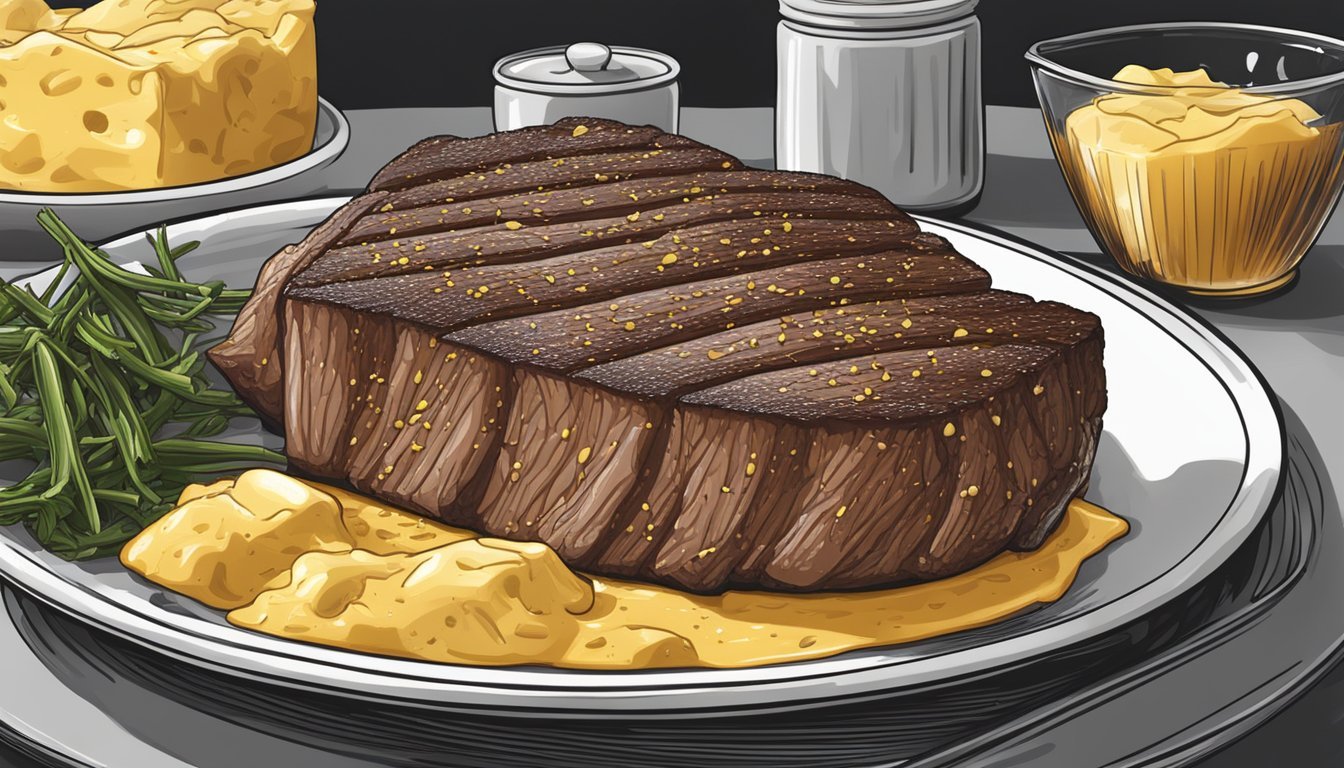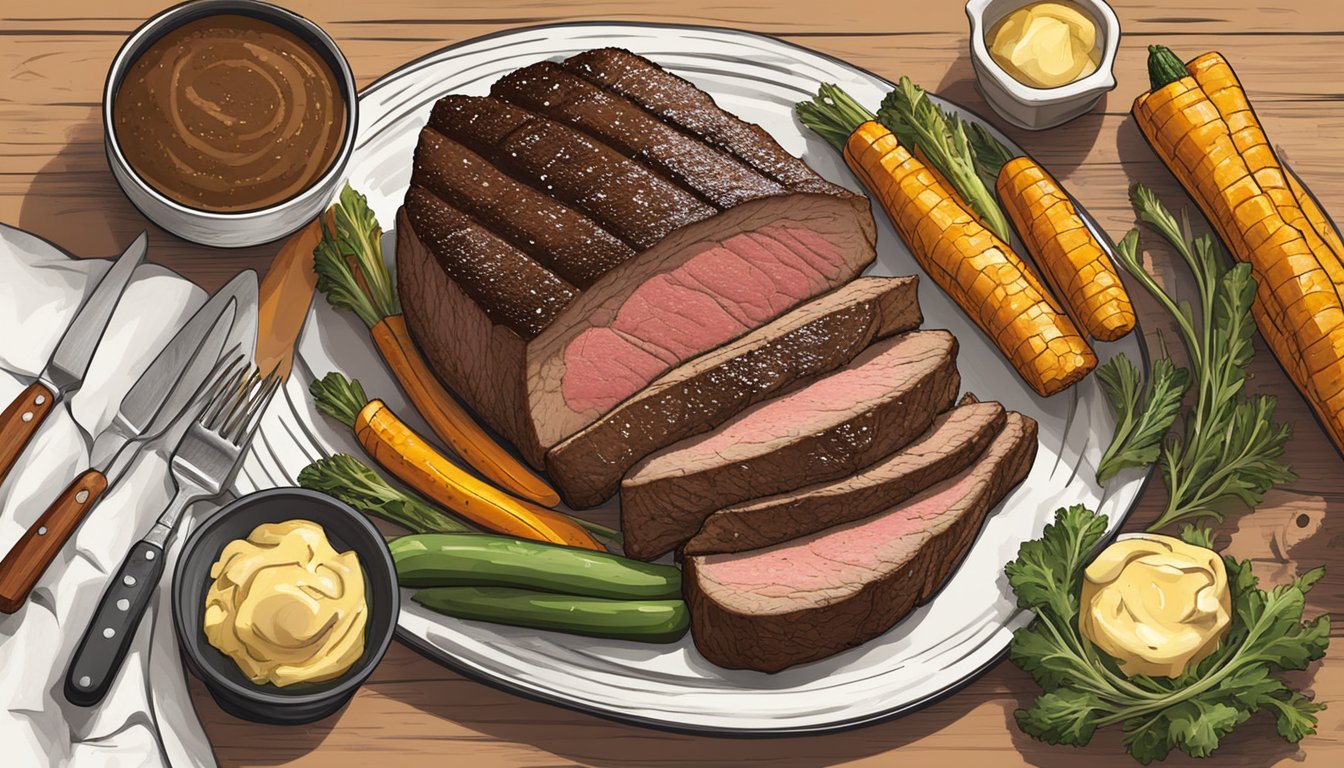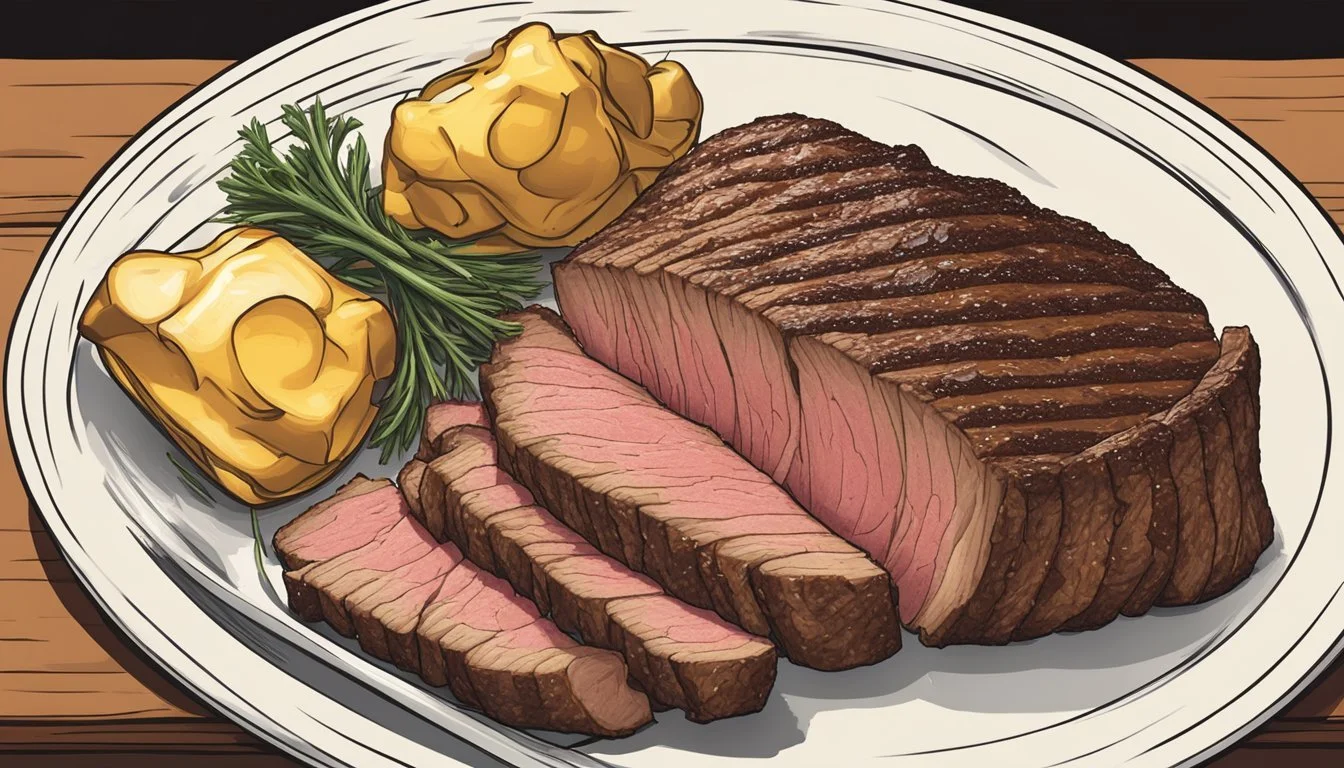Cowboy Butter Tri-Tip Steak
Savor the Richness with this Grilling Favorite
Cowboy butter tri-tip steak is a delectable dish that capitalizes on the ideal blend of a robust flavor profile and the lean, tender nature of the tri-tip cut. The tri-tip, hailing from the bottom sirloin subprimal cut of beef, is increasingly gaining popularity among steak enthusiasts for its rich beefy taste and versatility in preparation methods. Whether prepared on the grill or roasted in the oven, the tri-tip steak holds its own with a distinctive shape that tapers from one end, offering varying degrees of doneness in a single piece for a range of palates.
When infused with cowboy butter, an aromatic concoction made with butter, garlic, herbs, and a kick of heat from crushed red pepper flakes, the tri-tip steak ascends to new culinary heights. The compound butter not only adds a luxurious finish to the steak but also complements its naturally robust flavor, complementing the grilling or roasting methods that bring out the best in this cut. The butter is frequently prepared by blending softened butter with finely chopped ingredients, then chilled until solid, only to melt enticingly atop the hot steak.
With its lean texture and rich marbling, the tri-tip cut responds well to heat. Cooking techniques such as grilling over high heat or roasting over indirect heat are employed to ensure the surface of the steak is well-seared and caramelized, while the inside remains juicy and succulent. The goal is to reach the desired internal temperature, which is a measure of perfection for steak lovers. Once cooked to satisfaction, a slathering of cowboy butter on the freshly cooked steak promises a mouthwatering meal that is as visually appealing as it is flavorsome.
Selecting the Perfect Tri-Tip
When it comes to choosing a tri-tip, understanding beef quality and identifying key attributes can make all the difference for a flavorful result.
Identifying Quality Tri-Tip
Selecting quality tri-tip starts with examining the freshness and color of the beef. One should look for a rich, red hue with no signs of browning, which indicates a fresh cut. It's also important to ensure that the tri-tip comes from the bottom sirloin steak section, as it is known for its lean yet tender texture. The presence of slight marbling, which are thin streaks of fat within the muscle, can give an indication of the juiciness and flavor of the steak once cooked.
Sizing and Marbling
Size: A typical tri-tip steak should weigh between 1.5 to 2.5 pounds and be about two inches thick. This size allows for even cooking whether one is grilling or roasting.
Marbling: Look for well-marbled tri-tip as it enhances flavor and tenderness. However, the level of fat should be balanced; too little may result in a tough steak, while excessive marbling can overwhelm the inherent flavor of the meat.
Note: A well-marbled tri-tip should have fine streaks of fat distributed throughout the muscle, not just on the edges. This intramuscular fat will melt during cooking, infusing the meat with flavor and moisture, while contributing to a satisfying texture.
Preparatory Steps for Tri-Tip
Proper preparation of tri-tip steak ensures that it cooks evenly and absorbs the flavors of seasonings and marinades. The process involves two crucial steps: trimming the fat and applying the flavors.
Trimming the Cut
A tri-tip cut should be inspected for excess fat and silver skin before seasoning. Trim away any thick fat to prevent flare-ups and ensure even cooking. However, one should leave a thin layer of fat to maintain moisture and flavor during the grilling or roasting process.
Seasoning and Marinades
The tri-tip’s flavor can be greatly enhanced with the right blend of salt, pepper, and additional seasonings. Apply a generous amount of kosher salt and black pepper to all sides of the steak to create a basic but effective dry rub. For those looking for a more complex flavor profile, a marinade consisting of oils, herbs, citrus, and spices can tenderize the steak and infuse it with more nuanced flavors. Marinade the tri-tip for at least a couple of hours, or, ideally, overnight in the refrigerator to allow the meat to fully absorb the flavors.
Kosher salt
Black pepper
Optional: garlic powder, onion powder, smoked paprika
Example Marinade:
Olive oil
Lemon juice or vinegar
Crushed garlic cloves
Freshly ground black pepper
Chopped fresh herbs (e.g., rosemary, thyme)
Kosher salt
Regardless of the choice between a dry rub or marinade, it’s important to cover the tri-tip completely and let it sit, allowing the seasoning to penetrate the meat. This preparatory step is key in achieving a flavorful and juicy tri-tip steak.
Cowboy Butter: Adding a Rich Flavor
Cowboy butter elevates the taste of tri-tip steak with a rich blend of herbs, spices, and tangy citrus notes. It melds beautifully with the meat’s robust flavors during grilling or roasting.
Crafting Compound Butter
Compound butter is a simple yet impactful way to enhance a steak. The base of cowboy butter is unsalted butter, allowing the cook full control over the seasoning. To create it:
Soften the butter to room temperature for easy mixing.
Incorporate finely minced garlic and shallots for a pungent kick.
Fold in citrus elements, typically lemon zest and juice, for a bright acidity.
The cowboy butter should achieve a balanced harmony of flavors, and then be moulded into a log using plastic wrap or parchment paper before chilling until firm.
Infusing Herbs and Spices
The character of cowboy butter comes from the herbs and spices it carries:
Fresh herbs such as parsley and chives are chopped and mixed in for their fresh, grassy notes.
For a warm depth, chili flakes are added, which bring a gentle heat that does not overpower.
The steak's savoriness is further enhanced by a hint of Dijon mustard or smoked paprika.
This herb and spice infusion is not only about taste but also about creating an aromatic experience that complements the flavors developed in the steak during cooking.
Mastering Cooking Temperatures
To achieve the perfect Cowboy Butter Tri-Tip Steak, attention to cooking temperatures and methods is paramount. Utilizing a meat thermometer will ensure desired doneness, be it grilling, roasting, or a combination of both. The goal is often to reach a medium or medium-rare internal temperature, which translates to juicy, flavorful meat.
Grilling to Perfection
Grilling imparts a distinctive char and smoky flavor to tri-tip steak. To grill a tri-tip to medium-rare, preheat the grill to high, aiming for a temperature around 400°F to 450°F. A well-seared exterior while maintaining a juicy interior requires monitoring the steak's internal temperature closely.
Medium Rare: Grill each side for about 5-7 minutes, aiming for an internal temperature of 130°F to 135°F before resting the steak.
Medium: Grill each side for approximately 8-10 minutes, targeting an internal temperature of 140°F to 145°F.
Roasting and Oven Tips
Roasting a tri-tip in the oven is a method that produces a tender and evenly cooked steak. Preheat the oven to 375°F. For those opting to sear the steak beforehand, heat an oven-safe skillet over medium-high heat and then transfer to the oven.
Medium Rare: Roast in the oven until it reaches an internal temperature of 130°F to 135°F, which typically takes about 25-30 minutes for a 2-pound roast.
Medium: Roast until the internal temperature reads 140°F to 145°F, extending the cooking time slightly.
In both grilling and roasting, it’s critical to let the steak rest for about 10 minutes after cooking to let the juices redistribute. A meat thermometer is an invaluable tool in this process to ensure accuracy.
Cooking Techniques
Tri-tip steak is best when properly cooked, employing methods that bring out its rich flavors and tenderness. Searing on a cast-iron skillet initiates a Maillard reaction for a flavor-packed crust, while roasting provides a uniform internal cook.
Searing on Cast Iron
For an impeccable sear, one should heat a cast iron skillet over high heat. Before placing the steak in the skillet, one can lightly coat it with oil, ensuring the steak itself has been patted dry and seasoned. The tri-tip should be cooked for approximately 5 to 6 minutes per side, depending on thickness, to develop a deep, golden crust. If it begins to char too much on the outside and is still not up to the desired internal temperature, one can transfer the skillet to a 350°F oven to continue cooking to perfection.
Achieving an Even Roast
When roasting tri-tip, a consistent, even heat helps cook the meat thoroughly. Preheating the oven to a temperature of 350°F sets the stage for an even cook. One should start by searing the tri-tip to lock in juices and then transfer it into the oven. The roast continues in the oven until reaching the ideal internal temperature—135°F for medium-rare—making sure to turn the meat halfway for even cooking. Resting the meat after cooking allows juices to redistribute, ensuring each slice is as flavorful and moist as the last.
Creating the Ideal Crust
To achieve the quintessential crust on a Cowboy Butter Tri-Tip Steak, precise attention to dry rubs and the caramelization process is essential.
Dry Rubs and Seasonings
A robust crust starts with the right combination of dry rubs and seasonings. The basic components often include kosher salt, black pepper, and paprika, which not only impart flavors but also facilitate the formation of a well-defined crust. Careful application of dry rubs ensures that each bite is flavorful.
Salt: Draws out moisture and aids in crust formation
Black Pepper: Adds a sharp, piquant note
Paprika: Provides warmth and a subtle sweetness
Applying the rub generously on all sides of the steak creates an outer layer that will caramelise effectively under high heat.
Caramelization and Resting
The process of caramelization is critical for creating that sought-after caramelized crust. Cooking the tri-tip at a high temperature in the beginning is the chef's secret to achieving a deep, rich crust that is both savory and slightly crisp.
Sealing the Crust: Searing at a high heat for a short time to lock in juices
Resting: Allowing the meat to rest after cooking ensures that the juices redistribute, reinforcing the crust's texture
For the perfect crust, one must sear the steak on a preheated grill or pan and then allow it to rest for approximately 10 minutes before slicing. This process ensures the moisture within the steak fortifies the crust, making each slice juicy and full of flavor.
Complementary Side Dishes
When preparing Cowboy Butter Tri-Tip Steak, selecting the right side dishes enhances the meal's flavors and textures. This section provides a curated list of side dishes that pair perfectly with the richness of the tri-tip, ensuring a well-rounded and satisfying dining experience.
Vegetables and Potatoes
Grilled Vegetables: A medley of grilled vegetables complements the smokiness of a tri-tip steak. Vegetables such as bell peppers, zucchini, and asparagus can be brushed with vegetable oil, seasoned with salt and pepper, and grilled to perfection.
Bell Peppers: Slice into strips, coat with oil, and grill until tender.
Zucchini: Cut into rounds and season before grilling.
Asparagus: Toss with oil and garlic, then grill until slightly charred.
Roasted Potatoes: They offer a hearty and comforting addition to the meal. Small potatoes can be tossed in oil, seasoned with herbs, and roasted until golden brown.
Garlic Roasted Potatoes: Toss with minced garlic and roast.
Herb-infused Potatoes: Mix with rosemary and thyme before roasting.
Sauces and Butters
Cowboy Butter: A blend of creamy butter, herbs, and a hint of spice, cowboy butter serves as the ideal complement to a tri-tip steak's bold flavor.
Ingredients: Butter, garlic, parsley, chives, cayenne pepper.
Usage: Dollop on top of the steak or serve on the side for dipping.
Chimichurri Sauce: This vibrant sauce made with parsley, garlic, vinegar, and olive oil offers a fresh and herby contrast to the rich steak.
Composition: Parsley, minced garlic, red wine vinegar, olive oil.
Pairing: Drizzle over steak or use as a marinade prior to cooking.
Slicing and Serving
Slicing Cowboy Butter Tri-Tip Steak correctly is essential for showcasing its texture and flavor. Serving it with artful presentation elevates the experience.
Proper Slicing Technique
To optimize the tenderness of a tri-tip steak, one must slice it against the grain. The grain refers to the direction of the muscle fibers, and slicing perpendicularly to these fibers shortens them, enhancing the meat's tenderness. First, one should identify where the fibers change direction, which typically occurs at a seam of fat. Here, the steak should be cut into two separate pieces. Each piece is then sliced against the grain, with the knife held at a slight angle to produce slices of even thickness. For optimal texture, especially when aiming for a medium-rare finish, thinner slices are preferred as they balance the steak's robust flavor with a melt-in-the-mouth feel.
Presentation Tips
The presentation of Cowboy Butter Tri-Tip Steak should be both appealing and functional. Arrange the slices on a warm plate or platter to maintain the steak's temperature. Drizzle with the flavorful Cowboy Butter, ensuring each slice has a sheen of the rich sauce. Garnish with fresh herbs like parsley or thyme to add color and an aromatic touch. For a more formal setting, align the slices neatly, showcasing the medium-rare steak's rosy center and charred edges. Providing additional Cowboy Butter on the side allows guests to add to their taste, turning the meal into an interactive and savory experience.
Additional Tips and FAQs
This section responds to common queries and offers advanced guidance, ensuring enthusiasts can enhance their Cowboy Butter Tri-Tip Steak preparation and cooking technique.
Common Questions
What is the ideal cooking time for Tri-Tip steak? The cooking time for Tri-Tip steak can vary depending on the size of the cut and the desired level of doneness. A general guideline is to cook it using indirect heat for about 30-45 minutes, or until the internal temperature reaches approximately 125 degrees Fahrenheit for a medium-rare finish.
How does one achieve a flavorful crust with a steak rub? To achieve a flavorful crust, one should generously apply a steak rub consisting of salt, black pepper, garlic powder, and any preferred herbs. It should be massaged onto all surfaces of the steak and left to marinate for at least an hour or, ideally, overnight in the refrigerator.
Advanced Tips for Enthusiasts
What techniques can one employ for slow cooking Tri-Tip? For those who prefer slow cooking, one can first sear the steak over high heat to develop a rich crust, then transfer it to a cooler part of the grill. Maintain a consistent low temperature and allow the steak to cook slowly, which promotes tenderness and enhances the flavor profile.
How does indirect heat influence the cooking process? Using indirect heat is a technique whereby the steak is placed on a part of the grill that is not directly over the flames. This allows for a gentler cooking process, preventing the exterior from burning before the interior reaches the desired level of doneness. It's particularly effective for thicker cuts like Tri-Tip.









